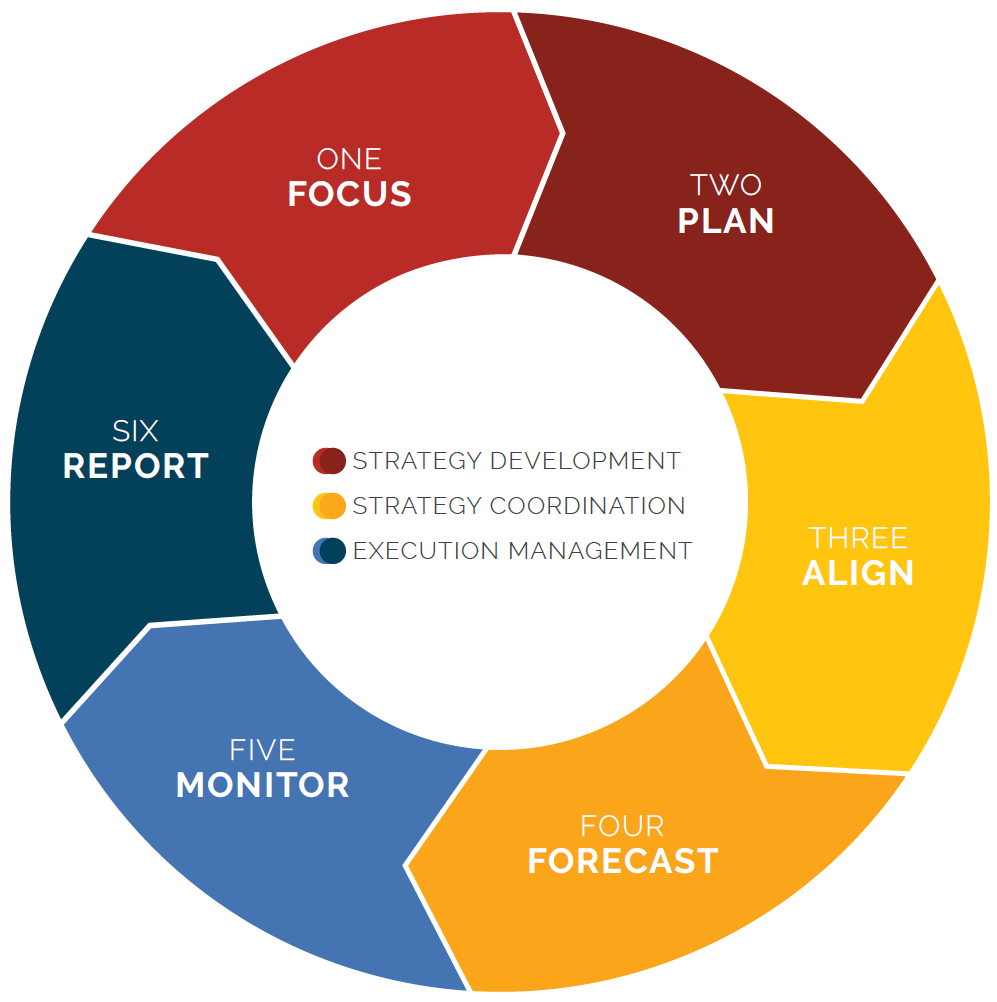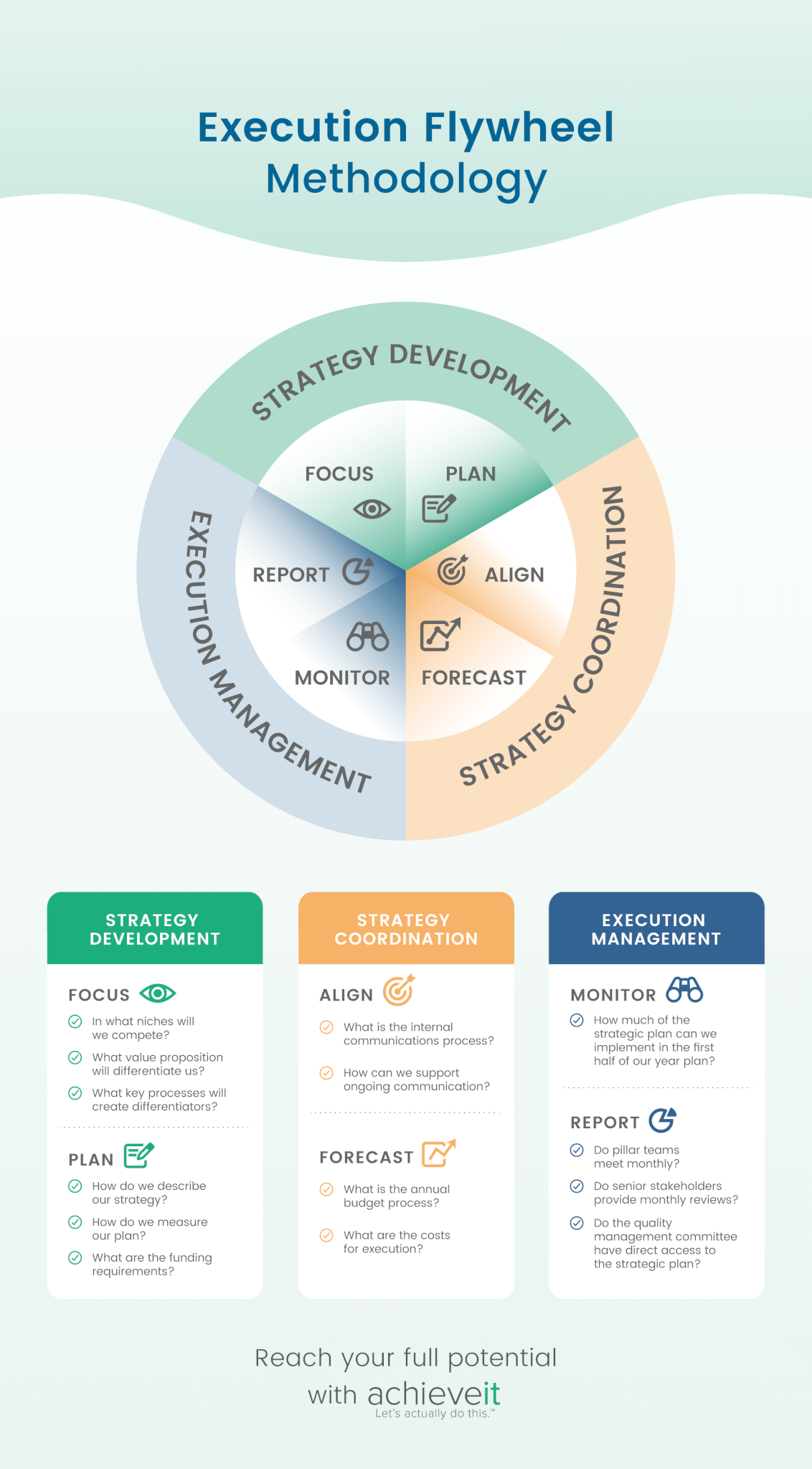The Execution Flywheel is a methodology for organizations that compete in aggressive markets, declining markets, or ones experiencing stagnant growth. Organizations in these situations have to find ways to increase quality or service while also reducing costs. Improving strategy execution is paramount.
In This Article
- How It Works
- The 3 Stages of the Execution Flywheel
- The 6 Phases of the Execution Flywheel
- Timing Implementation Using the 3-6-6 Cycle
- Download our Strategy Execution Flywheel Guide
- Reach Your Full Potential With AchieveIt
How It Works
The Execution Flywheel includes a six-phase process and a 3-3-6 timeline to increase your ability to execute well. Each phase builds on the next, so you can bulletproof your strategy, properly monitor your efforts, and leave time to pivot and improve your processes along the way.

The 3 Stages of the Execution Flywheel
The Execution Flywheel Methodology allows organizations to move seamlessly from strategy development to strategy execution while providing an idea of the tools required to monitor the success of the plan and activities of individuals in the organization.
The three stages are:
1. Strategy Development
The first stage of the flywheel is strategy development, which is comprised of your focus and planning stages. Here, you will collect and refine your mission and analytics to solidify your strategic approach in the coming year. We recommend conducting these processes during your fiscal year’s fourth quarter.
Phases 1 & 2, Focus and Plan, fall into this stage.
2. Strategy Coordination
The second stage of the flywheel is strategy execution, which comprises the align and forecast stages. Here, you will cascade objectives, allocate resources and implement your plan. We suggest you conduct these processes during the first and second quarters of the next fiscal year, so you allow time to evaluate results.
Phases 3 & 4, Align and Forecast, fall into this stage.
3. Execution Management
The last stage of the flywheel is execution management, comprising the monitor and report stages. Here, you observe execution, pivot if needed and study the resulting data. We suggest you conduct this stage during the third quarter of your fiscal year, so you can apply your insights to your next round of strategic planning.
While the first four phases deal with the development and coordination of the plan, phases five and six, Monitor and Report, address plan implementation and execution.

The 6 Phases of the Execution Flywheel
The Execution Flywheel is AchieveIt’s best-of-breed methodology for strategic and operational planning, and it follows a six-phase cycle:
- Focus: The gathering of business intelligence to focus your strategic/operational plans.
- Plan: The act of developing the plan, which includes, at a minimum, goals, objectives, strategies and tactics.
- Align: The cascading of assignments to members of management, and the allocation of appropriate capital, operational and human resources required to execute the plan effectively.
- Forecast: The linking of the strategic and operational plan to the budget and financial plan.
- Monitor: The oversight of plan implementation and execution.
- Report: The communication of plan results and performance to key stakeholders.
Let’s dive deeper into the Execution Flywheel.

Phase #1 – The Focus Stage
In this phase, organizations gather strategic business intelligence to focus on strategy development.
During this stage, the organization deploys various tools to learn about and understand opportunities and risks that must be considered during the strategic planning process.
Narrow in on essential opportunities and relevant risks affecting your organization’s strategic plan. Start by ensuring that goals resonate with all stakeholders — including any newcomers to the team. Speak with stakeholders during this phase to gain awareness of specific goals they are looking for and any issues they have noticed.
Once the intended trajectory is clear, create a strategic change agenda that includes the following steps:
Align With Analytics
Use data to determine areas of greatest potential growth and risk. This information will help your team see the projected and concrete insights of processes for various stages in the plan. Data can help drive business outcomes and influence strategies to make them as strong as possible.
Prioritize Pillars
Quantify the relative importance of your strategic themes or pillars.
Interview Executives
Use key stakeholders’ feedback to reorient and refine strategic priorities. Stakeholders play a vital role by setting up expectations and helping establish goals for the organization.
Study Capability Gaps
Identify potential market differentiators and constraints that could impede opportunities (i.e. strengths and weaknesses). Data and the reports you create will help you discover discrepancies with the current strategies and plan. Understanding the potential gaps enables you to develop strategies to target and address them, improving your organization’s operations.
Conduct a Pestel Analysis
Review external political, economic, social, technological, environmental and legal/regulatory landscape for short- and long-term opportunities and threats.
Complete a SWOT Analysis
Record strengths, weaknesses, opportunities and threats discovered in Capability and PESTEL analyses.
Create a Strategic Change Agenda
Convert your analyses into a blueprint for the strategic plan. Use these five questions as your foundation:
- In what niches will we compete?
- What value proposition will differentiate us?
- What key processes will create differentiators?
- How does this impact human capital?
- What tech is needed to support the strategy?
These questions will help you better understand and lay out the strategy needed to enable the organization to improve the areas it’s focusing on.

Phase #2 – The Plan Stage
In the planning stage, the strategic change agenda is converted into a plan that moves the organization toward its vision.
Doing this requires the members of the strategic planning team to address five specific areas:
How Do We Describe Our Strategy?
Create strategic themes, goals and objectives. These three elements help you focus on specific operations to improve upon and ensure all those involved will understand why the strategy is being developed and how the plan will help the organization see results.
How Do We Measure Our Plan?
Develop dashboards, a balanced scorecard and key performance indicators. By monitoring the actions taken to implement the plan, your organization has a better chance of following through with an effective strategy. Measuring the plan’s components also helps your team stay accountable and up to date with the recent findings.
What Action Plans Do We Need?
Create a series of strategies, tactics and actions that are required to achieve your objectives. Action plans will consist of various ways your team can accomplish goals. The developed processes may increase productivity and efficiency for the organization.
What Are the Funding Requirements?
Provide a detailed analysis of financial projections, including volume and revenue forecasts, as well as capital and operating budgets.
Complete this step prior to the budget process to ensure the plan assumptions, resources and funding requirements are carried over into the budget. Integrating the projected funding needs and changes takes work from multiple teams, so forecasting the requirements can make the transition into the plan easier once the budget is set.
Who Will Lead Strategy Execution?
Every element of the strategic plan should be assigned to specific individuals, with objectives assigned to senior-level executives and strategies and tactics assigned to the individuals who will be charged with execution.
Assignments should never be shared, as this often reduces accountability within the organization.

Phase #3 – The Align Stage
Once your strategic plan is complete, with budgets in place and assignments made, it’s time for execution. Implementation shouldn’t happen all at once, but be rolled out in a way that optimizes accountability and clarity.
Start at the Senior Level
Engage all business units and ensure that senior managers understand their roles and responsibilities.
Cascade Objectives
Cascade strategic plan objectives to managers throughout the organization. This prevents improper or unclear delegation of duties and responsibilities.
Clarify Communications
Develop an internal communications program to pave the way for greater alignment and more effective reporting. Regular internal communications ensure everyone involved stays on the same page.
Include pre-launch and ongoing communications throughout the year to keep teams aligned. Use town hall meetings, newsletters, banners, emails and more. Maintaining ongoing communications keeps stakeholders in the loop, which is crucial to being transparent about processes and making improvements that benefit the organization.
Align at All Levels
While strategic plan objectives are the domain of senior executives, they can be used to align your entire management team. For instance, a hospital’s Chief Nursing Officer may be accountable for a Patient Satisfaction Objective.
However, including patient satisfaction as an annual performance objective for all clinical nurse managers creates alignment and enhances the organization’s chance of success.

Phase #4 – The Forecast Stage
Few things are more frustrating to managers than being expected to implement a key component of your strategic plan without having the resources to execute it effectively.
The costs of execution – capital, labor and non-labor – must be identified during the planning process and then used as important financial assumptions when developing the annual budget. Identifying these costs of execution beforehand helps your organization plan accordingly for the budget and mitigate unplanned risks with finances.
In addition, growth and performance improvement objectives carry with them increased revenue and cost-saving opportunities, which are important drivers of the annual financial plan.
The financial impact of the strategic plan, along with the implementation costs, should provide the starting point for your annual budget process.

Phase #5 – The Monitor Stage
Once you’re ready to execute, you start the Monitor phase, which is when your strategic plan is executed, objectives are monitored and course corrections are made.
Focus on timely implementation and ensure you have tools in place to hold team members accountable. The faster you implement, the sooner you can expect to see results. Thus, don’t wait until the end of your plan year to execute your strategies and tactics, as there will usually not be enough time left for your efforts to take root and enhance the organization’s success. Instead, strive to implement as much of your strategic plan as possible in the first half of your plan year.

Phase #6 – The Report Stage
Successful implementation rarely happens by chance. To drive accountability and increase the likelihood that the plan will be effective and on time, it’s important to schedule regular strategic planning reviews.
These reviews should occur at three levels:
Pillar Teams
Strategic planning teams, usually formed around your strategic themes, should meet at least monthly to review the timetable, discuss obstacles and brainstorm alternative strategies if objectives are not being met. The pillar teams are crucial in the reporting stage because they have the most experience developing strategic plans for the organization and ensuring the processes work well. Meeting regularly to review the processes helps keep the team aware of everything as it happens and lets the members make changes as soon as possible.
Senior Stakeholders
Senior stakeholders should conduct a monthly review of the strategic plan objectives and provide direction to teams. With monthly reviews, stakeholders can assess the progress and make applicable and timely changes whenever needed.
Quality Management Committee
This team should regularly report on projects that have a direct link to the strategic plan. The quality management committee will oversee the integration of the plan, ensuring everything occurs efficiently and effectively. The team will review the plan following a specific procedure, so there are fewer risks for errors.
Quality management is an integral part of the reporting phase because it focuses on making sure the organization stays on track with its goals without sacrificing quality.
Timing Implementation Using the 3-6-6 Cycle
Mature organizations typically try to accelerate through the first four stages of the Execution Flywheel — Focus, Plan, Align and Forecast — thus allowing as much time as possible for stages five and six — Monitor and Report. Organizations that take too long to move into execution reduce their chance of success.
Ideally, stages should never overlap. Unfortunately, because many organizations take too much time to put their plan together, they are often required to begin next year’s planning cycle while they are still executing this year’s plan.
The 3-3-6 planning cycle resolves conflicts by eliminating overlaps.
- Conduct stages one and two in 90 days, typically during the third quarter of the organization’s fiscal year.
- Once those are complete, conduct stages three and four within 90 days during the fourth quarter of the fiscal year.
- In the last six months, which is the first half of the organization’s fiscal year, the organization will have time to see through the execution stage and adjust to it as required.
Whenever possible, the strategic plan should be implemented in six months. The benefits of this are two-fold.
First, if the entire plan is executed in the first half of the fiscal year, the organization still has six months to develop and implement alternative strategies and tactics if the strategic plan objectives are not being met. Second, it allows the organization to focus exclusively on developing next year’s plan in the second half of the year without diverting attention and resources to plan implementation.
Most critical in the timing of your strategic planning cycle is that the plan should be completed prior to the budget process. Plans prepared after the budget has been approved often lack the appropriate resources required for full implementation. To prevent this from occurring, time your 3-6-6 cycle so that stage two — Plan — is completed before the formal budget process begins. When this happens, the strategic plan then serves to provide budget assumptions in the form of increased volumes and revenues, decreased cost projections and capital and operational budget requirements associated with the strategic plan.
Download our Strategy Execution Flywheel Guide
AchieveIt is specifically built to support The Execution Flywheel because this methodology elevates accountability and drives execution thanks to its emphasis on monitoring progress and tracking data-driven results.
Our Execution Flywheel guide, will help you gain a deeper understanding of how this specific methodology can bulletproof the development of your plan and provide a timeline that emphasizes execution.
In this guide, you will learn:
- The six phases of the Execution Flywheel Methodology
- A timeline that increases your ability to execute well
- How to implement processes that encourage continuous improvement
- Critical components in timing your strategic plan
- How to leverage technology to start improving strategy execution
Reach Your Full Potential With AchieveIt
AchieveIt’s cloud-based software contains a full suite of tools that shorten the planning cycle, enable strategic decision-making and power accountability and execution. No other cloud-based application guides you through the entire Execution Flywheel with such focused precision.
Through our suite of cloud-based applications, we give every customer access to a set of tools that enable them to execute smarter, faster and better. We’ve added to this toolset a transformation roadmap that allows organizations to move easily from a culture of collaboration to a culture of individual accountability to a culture of execution — a natural path to becoming a truly innovative organization.
AchieveIt is changing the game by using a new approach to execution management and strategy development. We are passionate about helping organizations solve one of their biggest problems today: The ability to turn organizational vision and goals into real, meaningful and tangible results.
By combining our technology firepower with our human brainpower, we help organizations achieve short- and long-term success.
To experience it live, request a demo or take a self-guided product walk-through today.



